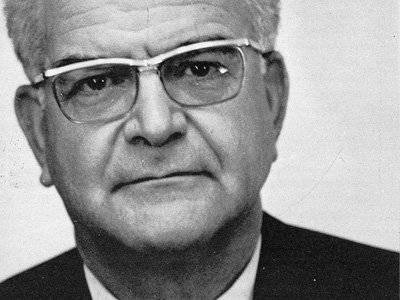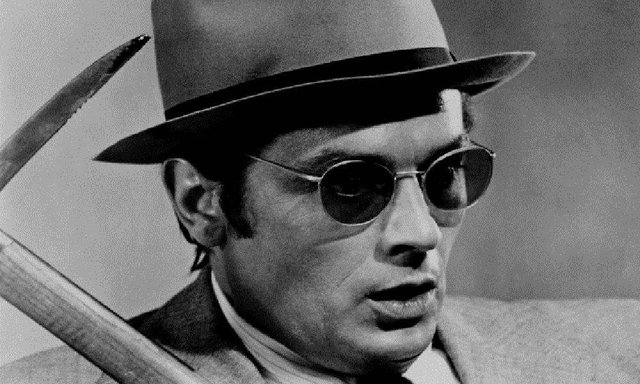A Heroic Spanish Secret Agent Assassinated Trotsky - His Amazing Story
The story of the death of one of the worst monsters of the 20th Century.
In August 1940, a Russian expatriate worked in his well-sheltered garden in Mexico City. He surrounded himself with chickens, rabbits, and peaceful trees. But the man was no vacationing grandpa—he was one of the most famous political exiles in the world, and his home in Coyoacan was surrounded by armed guards and fortress-like walls.
Leon Trotsky had been a political liability in Russia for years before his hasty expulsion. Though he had helped lead the Communist Party to power in Russia during the Bolshevik revolution in 1917, Trotsky quickly became persona non grata to Joseph Stalin. Trotsky’s opposition to Stalin's bloated bureaucracy and his publicly-stated belief that Stalinism wasn’t taking Communism far enough toward permanent world revolution cost him everything.

Ramón Mercader
When Vladimir Lenin died in 1924, it was thought that Trotsky, who had endured a long marriage of political convenience with Lenin, might come to power. But Stalin helped drum up and took advantage of anti-Trotsky sentiment to seize Soviet control instead. Stalin acted swiftly against the former hero, and he swept Trotsky out of his political positions, the Communist Party, and eventually the USSR itself.
As Trotsky looked for a new state to call home, Stalin scrubbed him from photographs and published texts, but Trotsky was more concerned about preserving his actual life. Though he managed to find political asylum in Mexico, he survived multiple assassination attempts over the years and a raid on his compound.
However, on August 20, 1940, Trotsky’s luck ran out. A man who called himself Jacques Mornard had become friends with Trotsky and his armed guards. They exchanged sympathetic political views and chatted about trivial matters, but Mornard was actually Ramón Mercader, a Soviet agent.

After drinking tea with Trotsky, Mercader found his chance. He used an ice axe intended for mountaineering to hack a hole into Trotsky’s skull. But the revolutionary wouldn’t die without a fight. He apparently grappled with Mercader, shouted for help, and even spat in his face and bit his hand during their altercation. Mercader was beaten by Trotsky’s guards and taken to prison.
Trotsky was removed from the scene of the crime and operated on, but he died some 25 hours after the attack. Mercader (as "Mornard") was swiftly arrested and tried, claiming he had murdered Trotsky because he would not allow "Mornard" to marry a woman he loved. He served 20 years in prison under his assumed identity, though asecret counterintelligence project finally revealed his real name. While the Soviet Union denied any involvement in the murder of Trotsky, Mercader moved to Russia after his release and was eventually given an award for being a “Hero of the Soviet Union.”
And as for Trotsky, the leader who fell from national hero to axed-down exile? He was buried in his own backyard.
Here is a more detailed account from another site:
Originally appeared in Metropolitan Barcelona:
On August 20th, 1940, a 27-year-old Catalan drove an ice axe into the head of Leon Trotsky at his Mexican home. The blow failed to kill him, and Trotsky struggled with his assassin. His guards, hearing the commotion, burst in and set upon the assailant, but Trotsky stopped them, exclaiming, “Do not kill him! This man has a story to tell.” Trotsky died the next day, and the murderer was turned over to the police. He identified himself as Jacques Mornard, a disillusioned Belgian Trotskyist. He said he had killed the old Bolshevik after quarrelling over a woman and was sentenced to 20 years in prison.
Though few knew Mornard’s true identity, the fact that the assassination had been ordered by Stalin was an open secret. Furthermore a number of Catalan republicans in Mexico knew something more. They recognised the killer’s photo in the press, but did not want to reveal his true identity for fear of provoking a reaction against the many Spanish refugees in the country. Finally in 1952, Mercader slipped up. A prison guard heard the “Belgian” singing a nursery rhyme Què li darem, en el Noi de la Mare? Què li darem que li’n sàpiga bo?1 in perfect Catalan from his cell. This clue led the authorities to his real identity: his name was Ramón Mercader, and he was indeed an NKVD agent.
Ramón Mercader was born in Barcelona to a well-to-do family on February 7th, 1913. His mother Caridad Mercader née Caridad del Río was from a family of aristocratic landowners in Santiago de Cuba. Following Spain’s loss of the colony in 1898, the family moved to Catalunya where Caridad, at the age of just 16, married Pablo Mercader, a rich Catalan industrialist. The couple had five children but Caridad grew to detest the staid, bourgeoisie existence and found herself drawn to the Bohemian life she discovered along El Paral.lel, with its heady mix of cabaret artists, bon viveurs and anarchists. Seduced by the latter’s revolutionary ideals, Caridad soon became involved in direct action, even setting fire to her husband’s factory before being caught and sent to a lunatic asylum. Her anarchist friends managed to spring her from captivity, and she fled to France with her children in 1925, never forgiving the Mercader family for imprisoning her.
In France, after her brief flirtation with anarchism, Caridad embraced communism, attracted by its discipline and surety of purpose. She become a fanatical Stalinist and eventually an NKVD agent. She also indoctrinated young Ramón as an ardent communist, filling him with hatred for all enemies of the party. In his early twenties, Mercader moved back to Barcelona, where he helped organise the then tiny Spanish communist party. For this involvement he was arrested and spent a brief period in prison, before being released in 1936 after the victory of the Popular Front.
At the outbreak of the Spanish Civil War in July 1936, Ramón took an active part in the successful defeat of the military rebellion in Barcelona. The war that would tear Spain apart had begun, but in Barcelona at least, the forces of the left, led by the CNT, were victorious. The anarchist CNT trade union was in virtual control of the city and at once set about collectivising huge swathes of Barcelona’s, commerce, services and industries. It was a revolution of historic proportions, comparable only with the Paris Commune and the Russian Revolution itself.
Against this tumultuous background, on July 23rd, the Catalan communist and socialists met in the Bar del Pi (La Plaça del Pi) and hurriedly joined together to form the PSUC (Partido Socialista Unificado de Cataluña), thus forming a new communist party, independent from Madrid. Moscow was deeply suspicious of this new Catalan organisation, which had broken the Comintern’s iron rule of “One State, One Party.” They need not have bothered; The PSUC soon proved itself to be a loyal servant of Stalin’s policies and was so successful at crushing socialist opposition from within that the model of merging the two parties was copied in Hungary and Poland in the late Forties.
Two days later, on July 25th 1936, the first column of volunteers was organised under the anarchist leader Buenaventura Durruti, and Ramón, though a communist, signed up to fight. He was seriously wounded on the Aragonese Front and returned to Barcelona in December. Here, his mother convinced him to become a Soviet spy, and he cut his teeth, reporting on foreign volunteers and teaching espionage to David Crook, a young British communist in charge of spying on George Orwell who was in Barcelona.
The war staggered on, but the NKVD had greater plans for Mercader and in July he was summoned to Moscow. There, he was trained in the arts of deception, sabotage and assassination and given the code name Gnome. In 1938, Gnome was set up in the Sorbonne area of Paris as a wealthy Belgium student, Jacques Mornard. He was handsome, impeccably mannered and endowed with flawless French and English. He quickly seduced Sylvia Ageloff, an American confident of Trotsky. The relationship paid off and he eventually gained an invitation to the home of the old Russian near Mexico City. Mercader’s mother had also moved to Mexico to oversee the operation, entitled, appropriately enough, “Mother.” Once Mercader had ingratiated himself within Trotsky’s inner circle, it was simply a case of choosing his weapon and moment.
After 20 years in a Mexican jail without revealing a word, Mercader was finally released in 1960, he was 47 years old. After a year exiled in Cuba, he moved back to the USSR and was presented with the Hero of the Soviet Union, awarded to him originally by Stalin. He was only one of 41 foreigners to receive the country’s highest accolade. Mercader would then divide his time between Moscow and Cuba, his mother’s birth country, staying as an honoured guest of Castro’s government. Meanwhile, his mother, Caridad, a constant shadow in his life, worked at the Cuban embassy in Paris. She died in 1975 in some luxury, surrounded by her jewels, perfumes and expensive clothes, an unrepentant Stalinist, reputedly drinking 40 coffees and smoking 80 cigarettes a day.
The years passed and Mercader grew increasingly homesick for his native Catalunya. With the legalisation of the Communist Party of Spain in 1977 and the return of many of its leaders, Ramón saw his chance, and asked the General Secretary of the Communist Party of Spain (PCE), Santiago Carrillo for permission to come home. Carillo, looking for an excuse to break with Moscow and a way to steer the party towards a Eurocommunist stance, invited Mercader to come back to Barcelona on the condition that he wrote his memoirs, telling all and naming his Moscow controllers.
Carrillo hoped that Mercader’s damning account would serve as justification for the rupture, but disciplined to the end, Ramón refused. Better to die in a foreign land than betray his comrades. Meanwhile, his party, the PSUC, went on to play a key role in the opposition to Franco and the transition of Catalunya. It underwent a process of destalinisation and eventually reformed in 1987 as Iniciativa, the current coalition partner in the Barcelona Council and Catalan government.
A man of his times, when individuals were swept away in ideological and geopolitical struggles, Ramón Mercader was a willing and murderous servant of Stalin to whom he remained stubbornly committed to until the very end. After dying of cancer in Santiago de Cuba in 1978, his ashes were flown to Moscow and buried in the Kuntsevo Cemetery, a place reserved for heroes of the USSR.
- ’What shall we give the mother’s boy? What shall we give him that tastes so good?’ One has to wonder whether he had in mind the constant dark shadow of his own mother when the rhyme slipped out.
Nick Lloyd leads Civil War tours in Barcelona with the Centre d’Estudis de Montjuic and runs www.iberianature.com.
Source: Mental Floss
Trotsky was a Bastard with big B. Thank you Mr. Mercader.